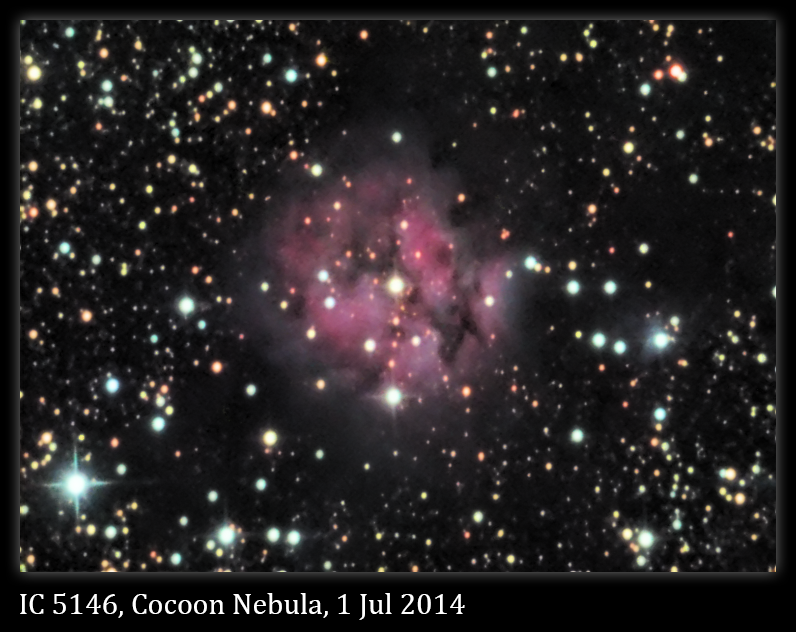The last two imaging sessions have seen “the best of times” and “the worst of times,” and both have involved favorite targets of mine.
The Dumbbell Nebula (M27) is one of the nearest planetary nebulas to Earth and is easy to find even with a Telrad sight alone because of its symmetric position at the corner of a rectangle formed by the bright stars of Cygnus. As I was setting up my imaging session the night of 30 Jun, I found it with my 15x70 binoculars while sweeping that region of the sky. I synched on the famous colored double star Albireo then did the goto M27 with the PicGoto. Sky conditions were outstanding (so this was the “best of times”). I put the scope near the house hoping to block the wind gusts I've had the last few sessions, but there were no gusts that night. I got the best guiding performance I think I've ever gotten. The mount was west-weighted; my mount seems to perform much better that way than east-weighted (or I've misunderstood and done it backward all along, but I don't think that's the case). I also used much higher aggressiveness (90%) and lower hysteresis (5%) on RA than usual. Finally, this was first light for the newest version of PHD2 (2.3.0). I had hoped to get a little more internal structure in the nebula, but this is still far better than my last attempt. Note that the stars are generally small and tight.
Date: 30 Jun 2014
Subject: M27, Dumbbell Nebula
Scope: AT8IN
Filter: none
Mount: CG-5 (Synta motors, PicGoto Simplificado)
Guiding: 9x50 Finder/Guider + DSI Ic + PHD 2.3.0 (Win 7 ASCOM)
Camera: DSI IIc chiller at 2.50 A, ~10 °C
Acquisition: Nebulosity 3.2.0, no dither
Exposure: 64x300 s
Stacking: Neb 3, bad pixel map, bias included, normalize first, trans+rot align, 1.5 SD stack.
Processing: StarTools 1.3.5.279 Crop; Wipe:Color & brightness 75%; Develop 82.26%; HDR:Optimize; Color:Scientific, 200%; Deconvolute auto mask 2.7 pix; HDR:Optimize; Life:Moderate; Track RNC 1.96%; Magic:Shrink 1 pix; Save; 2nd layer: HDR Reveal Core. CS6 Astronomy Tools Layer the Reveal Core layer under the other, top layer 60% opacity; Increase star color; Make stars smaller; Less crunchy more fuzzy; Astro Frame.
In contrast with these great conditions, last night was “the worst of times.” I left my gear out the night before, so the setup was identical to the night with excellent conditions. I decided to revisit another favorite target, the Cocoon Nebula (IC 5146), which I last imaged 2 years ago. I love the way the emission colors near the center of the nebula fade into reflection blues around the edges, which are in turn surrounded by dark areas where starlight from behind is blocked by the cloud. I synched on Deneb and used the PicGoto to easily find the Cocoon Nebula. Seeing was poor and on top of that I started in the Provo light dome. There was also some gusty wind. Unlike the excellent guiding I got the night before with the exact same balance conditions, guiding performance was terrible, especially in DEC. As a result, I threw out a lot of subframes and could have discarded more. I guess that goes to show that sky conditions really matter, perhaps even more than the quality and tuning of your equipment. The stars don't seem as tight in this image. Even so, the final image turned out better than expected. My theory is that standard deviation-clipped stacking probably helps (especially with bright components in the image), along with the fact that the dim parts are not terribly messed up by short-term mount excursions like those caused by seeing or wind.
Date: 1 Jul 2014
Subject: IC 5146, Cocoon Nebula
Scope: AT8IN
Filter: none
Mount: CG-5 (Synta motors, PicGoto Simplificado)
Guiding: 9x50 Finder/Guider + DSI Ic + PHD 2.3.0 (Win 7 ASCOM)
Camera: DSI IIc chiller at 2.50 A, ~12 °C
Acquisition: Nebulosity 3.2.0, no dither
Exposure: 56x300 s
Stacking: Neb 3, bad pixel map, bias included, normalize first, trans+rot align, 1.5 SD stack.
Processing: StarTools 1.3.5.279 Crop; Wipe:Color & brightness 75%; Develop 82.80%; Color:Scientific, 250%; HDR:Optimize; Deconvolute auto mask 2.5 pix; HDR:Optimize; Track RNC 1.23%; Magic:Shrink 1 pix; Life:Moderate. CS6 Astronomy Tools Increase star color; Healing brush; Astro Frame.


No comments:
Post a Comment